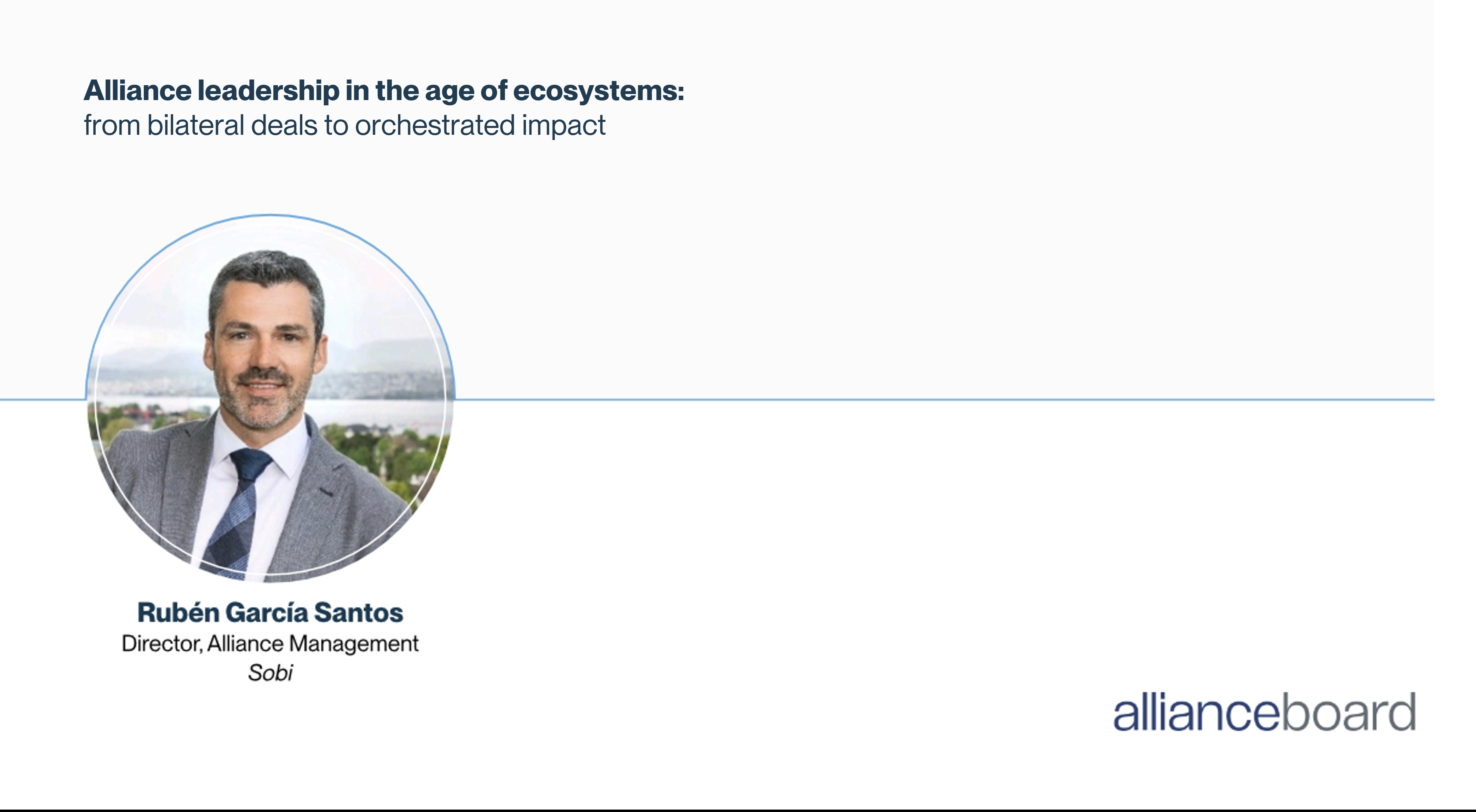Alliance leadership in the age of ecosystems: from bilateral deals to orchestrated impact

By Rubén García Santos, Director, Alliance Management at Sobi
Healthcare innovation is no longer powered by single breakthroughs or bilateral deals; it’s propelled by ecosystems that connect biopharma, MedTech, deep tech, providers, payers, public institutions, and patient groups in dynamic networks. The leaders who will thrive are those who can design, govern, and adapt these multi-stakeholder systems to co-create value at speed and scale.
Over the past few years, I’ve seen a decisive shift: traditional partnerships remain vital, but they’re now part of a broader, faster, and more interconnected landscape. Success depends less on the elegance of a contract and more on our ability to continuously align incentives, data flows, and decision rights across diverse actors. In other words, we must move from “structuring a deal” to orchestrating an evolving ecosystem.
What ecosystem leadership requires
Ecosystems raise the bar on leadership. We need new levels of agility, trust-building, and governance to keep collaboration effective as conditions change. The work is not theoretical: healthcare is shifting from reactive disease care to proactive health management: prevention, patient empowerment, and system optimization, where gaps in early diagnosis, real-world data, and equitable access can only be solved through collective action. Corporations contribute scale and channels; startups contribute novel science and speed; public stakeholders bring reach and accountability; patient advocacy groups keep purpose and outcomes front and center.
What it looks like in practice
Consider digital health platforms that simultaneously collaborate with pharma on medication management, tech firms on AI, providers on clinical validation, and patient groups on experience design. Elsewhere, AI innovators co-develop predictive diagnostics with health systems; biotech companies pair with cloud and analytics leaders to advance personalized medicine; and public health organizations team with private partners to expand last-mile access. In cell and gene therapy or digital therapeutics, research institutions, biotech, and technology providers now codevelop not only treatments but also the operating models that deliver them. These are ecosystem plays—not one-to-one deals.
The hard parts and how to navigate them
Ecosystems multiply complexity. Regulatory frameworks for novel modalities and combined products are evolving. Supply chains must be resilient. And the cultural distance between partners can undermine even the best governance if we neglect trust and shared purpose. I’ve learned that aligning time horizons is essential: biotechs live in quarters, hospitals in annual budget cycles, and governments in multi-year policy windows. Breaking execution into staged milestones with clear value at each step helps synchronize these clocks while sustaining momentum.
When entering new markets or scaling new solutions, leading organizations don’t just “launch”, they integrate into existing ecosystems (or build new ones where needed). That means convening hospitals to map care pathways, partnering with patient groups to surface access barriers, working with universities to expand capacity, and aligning with public authorities on national priorities. The outcome is a co-created path that balances public health impact, commercial sustainability, and technological scalability.
From alliance manager to ecosystem orchestrator
As ecosystems become the default, the role of alliance professionals is evolving from support function to strategic catalyst. Think of the rise of chief digital officers a decade ago: initially misunderstood, now central to transformation. Similarly, alliance leaders are stepping up to shape how organizations collaborate (beyond bilateral constructs) by building networks that tackle systemic challenges.
To do this well, we must operate in three capacities:
1 - Ecosystem orchestrator: assemble, govern, and nurture partner networks that rapidly recombine capabilities as needs change.
2 - Strategic catalyst: spot and activate partnerships at the intersections of industries and sectors.
3 - Value architect: co-design business models and incentive structures that align diverse metrics of success.
This blend of science, business, and design thinking applies in healthcare and adjacent arenas like AI, deep tech, and sustainability.
Principles that raise the odds of success
- Purpose before process. Governance matters, but it only works when grounded in a shared mission and clear outcomes. Start with the “why,” then codify the “how.”
- Design for learning. Treat the ecosystem as a living system. Build feedback loops using real-world data, iterate operating models, and adjust partner roles as the context shifts.
- Align the clocks. Use milestone-based roadmaps to connect quarterly, annual, and multi-year goals, and make trade-offs explicit early.
- Co-own value. Incentives must reflect the full value chain: from scientific risk and regulatory navigation to adoption and health outcomes—so partners pull in the same direction.
- Center the patient. Let patient insights shape priorities, design, and measurement; it keeps ecosystems grounded and credible.
The leadership mindset
The leaders I most admire and strive to emulate transform complexity into clarity. They don’t wait for perfect information. They create alignment around purpose, make timely decisions, and use uncertainty as a catalyst for progress. In a world that can feel like it’s pulling apart, our work is to bring organizations together for meaningful, measurable impact.
The bottom line: The future of healthcare will be shaped by leaders who can envision, design, and steward ecosystems where diverse minds collaborate effectively. As prevention, patient empowerment, and system performance become the north stars, ecosystem leadership will determine who turns promising science and technology into real-world outcomes consistently and at scale. It’s time to invest in alliance and ecosystem management as core strategic capabilities, and to build a better future, one alliance at a time.
Contact us if you'd like to learn more about how Sobi and other partnering leaders use allianceboard, the digital ecosystem management platform to drive alliance success.
